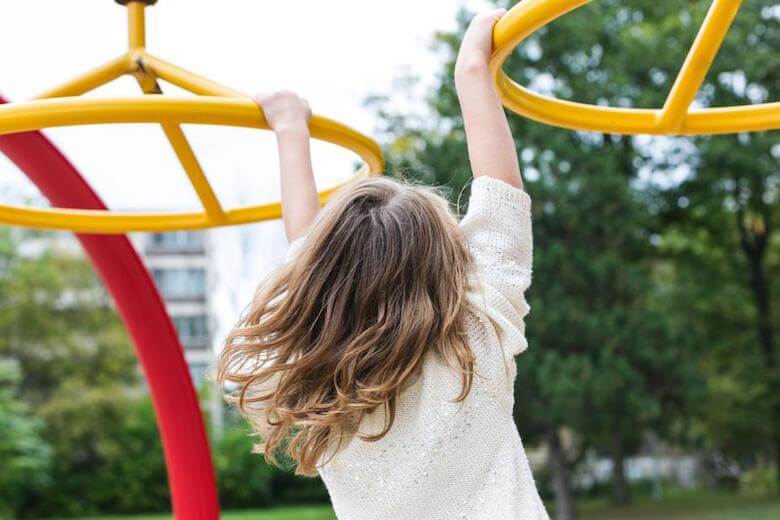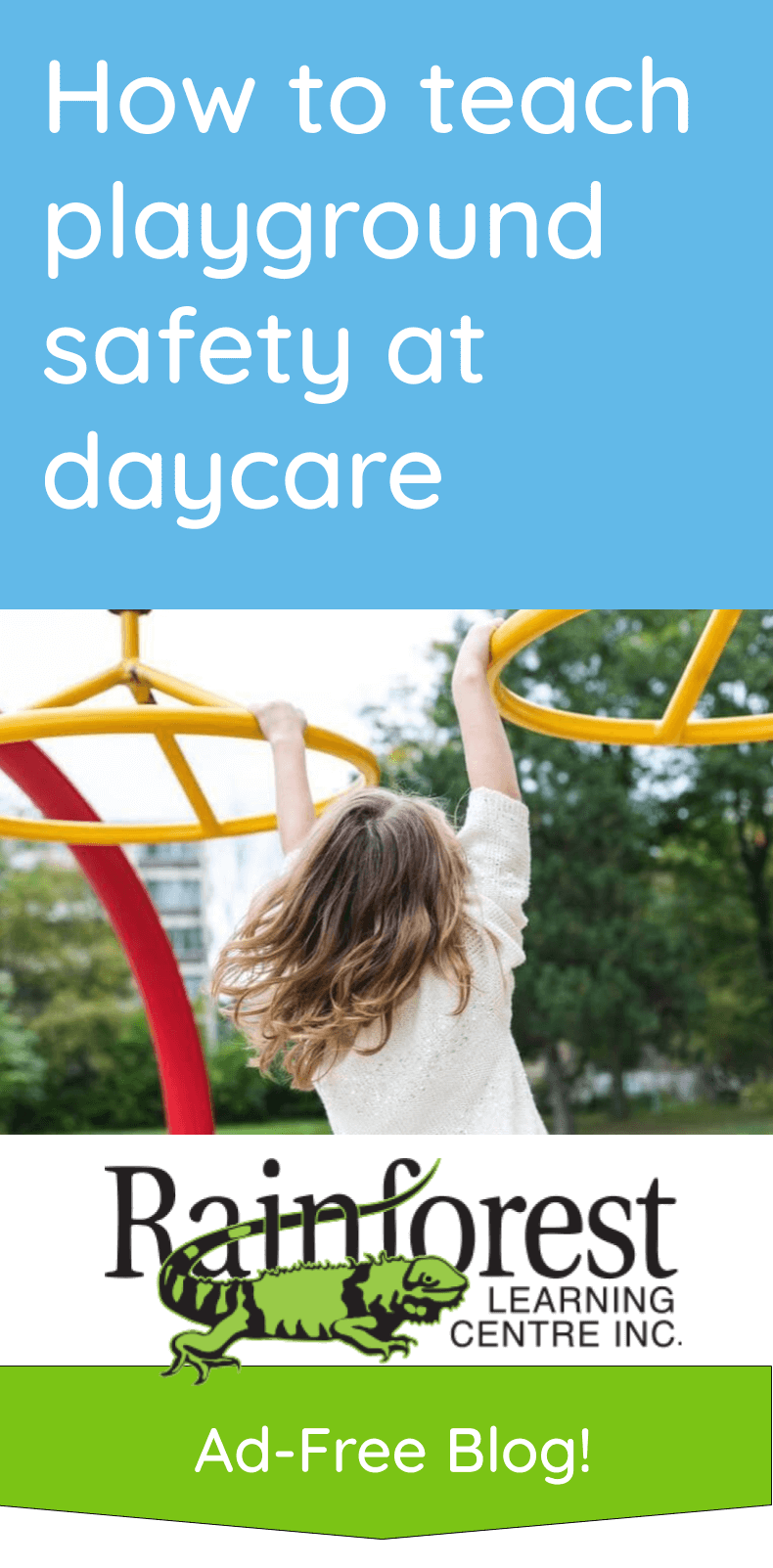
Injuries on playgrounds are a serious issue. According to the The Canadian Paediatric Society, 29,000 children up to age 15 go to the emergency room for playground injuries. While that’s not a staggering statistic, no parent wants their child to be part of that 29,000. Most of these injuries happen to kids aged 5 to 9, and most are from falling, which result in fractures. The good news is that bigger injuries (such as head injuries and open wounds) were reduced when playgrounds got safer, and more people began paying attention to playground safety rules.
So, in short, it’s important that we keep reminding our daycare kids to be safe on the playground. This applies to early childhood educators and caregivers supervising children too. Below we’ll outline some of the major ways to teach playground safety at daycare.
Teach kids and caregivers to scout their play area and playground equipment
It’s important that adults and kids alike learn to keep their eyes open for any potential hazards on a playground. It’s easy to get excited when arriving at a playground, and to charge ahead and get playing right away. The adults ‘in charge’ usually notice ‘big’ things, like maybe a wet, slippery slide. But if we’re honest, we mostly assume the playground is safe. And, we’re not exactly going to go through a 20-point-checklist before touching playground equipment either (though, we technically should, and would encourage it).
So, one way to handle this is to make sure that during play, kids are aware of safety standards. Before heading to the playground, daycare educators should be conversing with kids about this issue (like, during circle time, for instance). The good news is that kids pick up facts pretty quickly, and some of them (depending on personalities) like to point out the ‘rules’ too!
The type of instruction will vary depending on the age group of the daycare kids you’re teaching about playground safety. But, in general, kids should be attuned to:
- Any loose parts on the playground. If they see a bar that isn’t tightly screwed in, or a swing hook or pole leg that looks wobbly, they should tell their teacher or parent right away, and ask the other kids not to go near that equipment.
- Wet, slippery surfaces, such as on the slide (especially since kids like climbing up them). The kids should know not to step on the very wet playgrounds, however tempting it may be!
- Very hot surfaces. Sometimes, playground equipment made of metal, or even plastic, can get hot in the summer. Always touch metal slides and rails softly before letting them burn you.
- Hard foundations or lack of soft cushioning on the ground. This is the most serious cause of injury on a playground. The ‘padding’ on the ground should not only be made of a soft material, it should also absorb the impact of the fall. For that, it should be at least 10 – 12 inches thick, and extend at least 6 feet around the playground equipment. Grass or dirt are too hard for potential playground falls. Pea gravel, wood chips or other synthetic material should be used. Otherwise, honestly, we’d say to just avoid the playground all together.
- Tripping, bruising and cutting hazards. And, while rocks, sticks and toys may be part of the playground scene, make sure kids know they shouldn’t be in the way, especially on slides, or places they can trip. Balls, jump ropes and toy cars can be real hazards in those small climbing spaces, especially with elevated openings that can just ‘scream’ for an unintentional fall. For wood parts of a playground, make sure there are no breakages that could cause splinters or cuts.
- Sharp objects that don’t belong on the playground. This includes needles, broken glass, nails or other objects left behind by irresponsible citizens (yes, we said it!).
- ‘Dirty’ things that don’t belong on the playground. This is gross, but sometimes things like used condoms, and those needles we mentioned above, are left on playgrounds or their surrounding fields. Kids should be ultra sensitive to not touch these things. First, get an adult. This also applies to trash, dead animals, and the like. Kids need to be taught that these can be dangerous to their health; it won’t come naturally to their logic.
Sometimes, the above pointers can be taught to daycare kids while they’re on the playground, as teachable moments. But our suggestion is to teach them to the group beforehand. You can do this with photographs, like flashcards. You can also quiz the kids with random questions each day, before they go out the door for playtime.
Remember, maintenance is not always required after a playground is installed. And, if the equipment is older, it may not come with modern safety features or standards. For example, swings may be too close together, or not have enough clearance behind and in front of the set. Perhaps no one thought of these things at the time the playground was erected, or the fencing was put in place. So these things need to be spotted by those supervising children.
This article explains, in detail, the appropriate safety standards and measurements to look out for, when analyzing playgrounds for hazards. The Canadian Standards Association also has a published guideline for keeping playgrounds safe. Alberta Health Services publishes an easy checklist to follow for playground safety, which you can find here (you can use this for quizzing the kiddos too!).
Ensure daycare kids know the rules for playgrounds
Kids should learn early on how to play safe on the playground. They should be able to see the rules written down (with visuals too, in case they can’t read yet). They should also be taught and reminded the rules. And, early childhood educators at daycare should be practicing and demonstrating the rules with them.
These should include:
- Feet first going down the slide (never head first). Then, quickly get out of the way. No stopping on the way down either, and no climbing up the slide.
- Waiting turns, and letting other kids have a chance on all playground equipment, one at a time (swings, slides, etc.). No pushing at all!
- Sit down on the swings, never stand on them, and never jump off of them while they’re in mid-air. Always hold on with two hands.
- Staying away from swinging swings, so you don’t get it. If you’re pushing someone on the swings, make sure you leave enough clearance so you don’t get knocked over on their way back to you.
- No climbing over guard rails, or barriers meant to prevent falling. These are not the monkey bars!
- Big kids should be aware of little kids, and play gently around them.
- No throwing sand, mulch or rocks.
- If there are separate parks for younger and older kids, they should stay in those zones.
- No wandering off without an adult knowing where they are.
Plus, all the other cautions mentioned in this article.
Repeating and emphasizing these types of rules help kids become aware of the dangers they could face. It may seem mundane and perhaps, sometimes unnecessary, but we still recommend it’s always done.
Teach kids about age-appropriate playground equipment
One of the other major reasons for potential injuries on playgrounds, especially with preschool-age kids, is that they are using the wrong play equipment for their age.
A rule of thumb to teach kids is that they should be able to reach whatever they want to play on, by themselves. Now, that gets tricky with climbing structures, which many playgrounds have. These are not bad, per se. They can teach gross motor skills, balancing confidence and they can build on strength. Nonetheless, they should be safe.
Different children can have different agility skills at different ages. So we wouldn’t want to say that all children of a certain age shouldn’t be climbing rope nets or planks. An adult should be able to tell whether a child struggles with security while climbing.
Also, some playground parks specifically have different areas for different ages. The playground equipment for toddlers and preschoolers, for example, will have smaller stair-like steps to get up to a slide. Whereas a school-age playground for older kids may only use ladders (metal or rope), which will may be too hard for a toddler to climb anyway.
But, if a caregiver helps a small child to get up high on a playground structure, they need to be fully aware that the child also won’t know if they are approaching danger – such as an opening to slide down a pole, which is meant for older kids.
A young child may also approach an area where older kids are playing, which can be dangerous. For example, they may run into a moving carousel or see-saw. Adults should be near the child at all times, especially if a child under 5 is playing on these structures. Never sit on the bench at a distance and hope that a preschooler will just ‘figure it out.’
Teach kids about playground-safe clothing
Yes, clothing can be a hazard to children. On a playground, when they’re going fast, and not quite concentrating on anything but having fun, these hazards can be even more dangerous. Teach kids at daycare to leave behind the following types of clothing when heading to a playground:
- Scarfs
- Clothing with drawstrings, like hoodies (kids shouldn’t be wearing these at all, anyway)
- Loose or big clothing (such as pant legs they can trip on).
- Helmets
Kids should always wear shoes on playgrounds, to avoid getting cuts and splinters. However, shoes with laces can be a tripping hazard. Try opting for velcro, buckle or slip on shoes instead.
Report the dangers you see on playgrounds, to make them safe for everyone
When you see a playground safety issue, don’t just ignore it and assume someone else will deal with it. Others may be thinking that too. It’s important to report the problem to the right authorities. If it’s on the grounds of a residential complex, tell the building manager. If it’s at a school, call their office or the superintendent of the school district. If it’s on a public park, notify the local city hall or authority.
See more on our blog:
- Basic first aid and emergency response skills to teach in preschool
- Tips to teach street and road safety at preschool
- Teaching young kids about stranger safety
- Teaching daycare kids about food safety
- What makes a good daycare space design?
- Tips to prepare a daycare or preschool for earthquakes
- 4 Top benefits of outdoor education in early childhood
- 4 Benefits of daycare ‘buddy time,’ when older kids mentor preschoolers
Photo by Sarah Pflug from Burst
